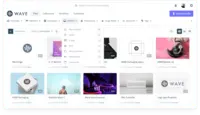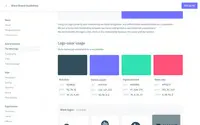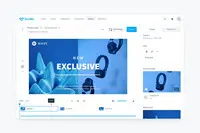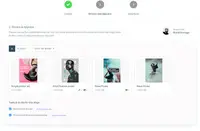Overview
What is Bynder?
Bynder helps brands to distribute their marketing materials, manage creations and facilitate brand consistency. Bynder is a solution for marketing that comes with best in class digital asset management, creative project management, brand identity guidelines, product information management and web-to-publish…
Recent Reviews
Pricing
Enterprise Brand Portal
$0
Cloud
User/Storage/Modules/Add-Ons
Entry-level set up fee?
- Setup fee optional
For the latest information on pricing, visithttps://www.bynder.com/en/pricing/
Offerings
- Free Trial
- Free/Freemium Version
- Premium Consulting/Integration Services
Product Demos
Bynder integrates with Wordpress 5
YouTube
Bynder integrates with Salesforce Marketing Cloud
YouTube
On-brand content creation and collaboration with Bynder Print Brand Templates
YouTube
Streamlining the creative process with Bynder Creative Workflow
YouTube
Delivering optimized assets with Bynder DAT
YouTube
Product Details
- About
- Integrations
- Competitors
- Tech Details
- FAQs
What is Bynder?
Bynder is a digital asset management (DAM) platform that enables teams to manage proliferating content, touchpoints, and relationships. Bynder presents itself as a brand ally that unifies and transforms the creation and sharing of assets.
Bynder states that brand managers, marketers and creatives from global organizations like PUMA, innocent drinks, Spotify, Five Guys, Omron and KLM Royal Dutch Airlines use Bynder to organize company files; edit and approve projects in real time; auto-format and resize files; and make the right content available to others at the click of a button.
Bynder states that brand managers, marketers and creatives from global organizations like PUMA, innocent drinks, Spotify, Five Guys, Omron and KLM Royal Dutch Airlines use Bynder to organize company files; edit and approve projects in real time; auto-format and resize files; and make the right content available to others at the click of a button.
Bynder Features
DAM Features Features
- Supported: Uploading assets
- Supported: Downloading assets
- Supported: Categories
- Supported: Asset storage
- Supported: Asset sharing
- Supported: Asset search
- Supported: Tagging system
- Supported: Content editing
- Supported: Embed codes
- Supported: Metadata
- Supported: Collections
- Supported: User access
- Supported: DAM Integrations
- Supported: DAM API
- Supported: Workflow automations
- Supported: Related asset discovery
Reporting & Analytics Features
- Supported: Dashboards
- Supported: Standard reports
- Supported: Custom reports
- Supported: Data exportability
- Supported: Content analytics
Additional Features
- Supported: Digital Asset Management
- Supported: Brand Guidelines
- Supported: Creative Workflow
- Supported: Studio
- Supported: Print Brand Templates
- Supported: Content Workflow
Bynder Screenshots
Bynder Videos
Automating digital content creation with Bynder Studio
The Bynder x AI search experience
Bynder Integrations
- Salesforce Marketing Cloud
- SAP Commerce Cloud
- Salesforce Commerce Cloud
- WordPress
- Sitecore Experience Manager
- Templafy
- Contentful
- Acquia Digital Experience Platform
- Asana
- Microsoft SharePoint
- Akeneo
- Bigtincan
- Contentstack
- Kentico Xperience
- Kontent.ai
- Bloomreach Commerce Experience Cloud
- monday.com
- Highspot
- Dropbox
- Optimizely Content Management System
- Shopify
- Stibo Systems Multidomain MDM
- Adobe Workfront
- Storyblok
- Wrike
- Seismic
- Adobe Experience Manager
- Akamai
- Box
- Canva
- Drupal
- iStock, from Getty Images
- Getty Images Enterprise Solutions
- Google Drive
- Google Analytics
- Microsoft Teams
- Shutterstock
- Showpad eOS®
- Figma
- Foleon
- Magnolia
- Moovly
- Prezi
- Progress Sitefinity
- Salsify
- Smint.io
- Storyteq
- TINT
- Tray.io
- Workato
- Stensul
- Trello
- Hootsuite
- ButterCMS
- Publitas
- Vimeo
- Tridion
- inriver PIM
- Microsoft 365
- Crownpeak CMS
- DIGIDECK by Sportsdigita
- Adobe Marketo Engage
- Unsplash for Brands
- HubSpot Marketing Hub
- Adobe Commerce (Magento Commerce)
- Ciloo
- Colect
- Hygraph
- Sprinklr Marketing
- Pixyle.ai
- IMATAG
- Netlify Create / Stackbit
- Nosto Commerce Experience Platform
- Mobius Labs
- Veriflies
- Creative Force
- Adobe Creative Cloud
- Google SSO
- eGo CMS
- DDP-Suite
- HelloPrint
Bynder Competitors
Bynder Technical Details
| Deployment Types | Software as a Service (SaaS), Cloud, or Web-Based |
|---|---|
| Operating Systems | Unspecified |
| Mobile Application | Apple iOS, Android |
| Supported Countries | All Countries supported |
| Supported Languages | English, German, Dutch, French |
Frequently Asked Questions
Bynder helps brands to distribute their marketing materials, manage creations and facilitate brand consistency.
Bynder is a solution for marketing that comes with best in class digital asset management, creative project management, brand identity guidelines, product information management and web-to-publish modules.
The most common users of Bynder are from Mid-sized Companies (51-1,000 employees).
Bynder Customer Size Distribution
| Consumers | 0% |
|---|---|
| Small Businesses (1-50 employees) | 15% |
| Mid-Size Companies (51-500 employees) | 25% |
| Enterprises (more than 500 employees) | 60% |







